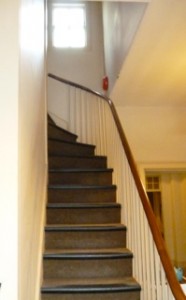Secrets from the room at the top of the stairs
A new project on the royal servants at the Royal Pavilion. Tracy Anderson, a post-doctoral researcher from the University of Sussex, is delving into the real lives of the servants and staff who once walked the tiled corridors and the backstairs of the Pavilion.
For three weeks now I have been tucked away in a small round room at the top of Brighton Pavilion. room has a domed ceiling and little round windows punctuate the walls. It is one of the ‘bottles’ or small domes that identify this iconic Brighton building and was once part of the servants’ quarters. This is absolutely fitting because it is the hidden histories of the servants at the Pavilion that form the basis of my research. The room has a strange echo, probably caused by the shape of the ceiling. But my imagination runs. How right it seems to be working in a room where a royal servant may once have slept. Today this room houses the extensive archives of the Pavilion; documents, press cuttings, architects plans, scholarly articles, exhibition catalogues and records of building works. There is also a wealth of information about the people who lived there. The life of its most famous, or infamous, resident the Prince Regent, later George IV is well known. What we know less about however, are the people behind the scenes, the servants who made the parties happens, who ‘oiled the wheels’, who cooked, cleaned, serviced the royal apartments, waited at table, tended the garden, kept the ice house…..I could go on. What was a Page of the Backstairs, what did the livery look like, where did the kitchen maid sleep and who dressed the King himself? Who lived at the Pavilion and who travelled down with the monarch from London? The management of the Pavilion was a mammoth task. It involved, not only a permanent staff at the Pavilion itself, but the movement of many of the Royal Household from London, each time the Prince Regent, or later King, would visit. To answer these questions a lot of digging needs to be done. Many servants could not write and didn’t have money to commission portraits. Diaries and portraits are therefore scarce. Information has to be gleaned from other sources, invoices, records of appointments to the Royal Household, press cuttings, and through collaboration with experts on costume and livery, with the Royal Archives at Windsor. But with a lot of time and a bit of luck we should be able reveal something of the neglected lives of the real people who worked here over two hundred years ago. Watch this space.

